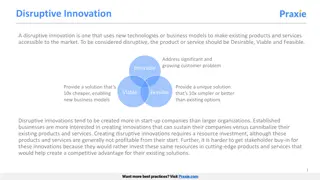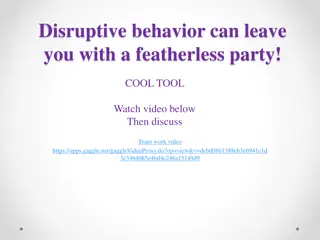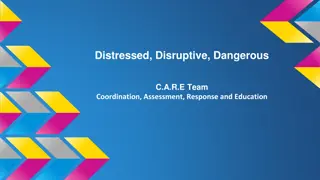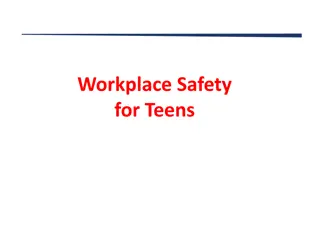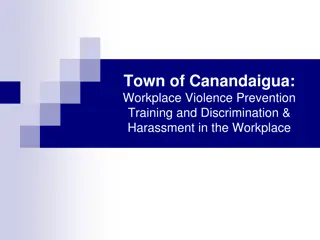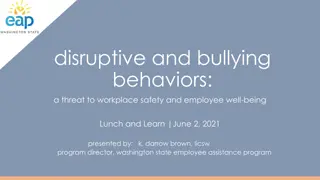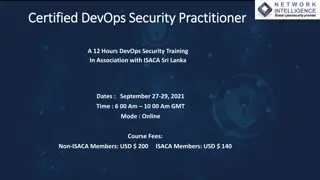Workplace Safety and Security Workshop: Managing Disruptive Behavior
Exploring workplace violence, the right to refuse work, and strategies to prevent and address disruptive behavior in the classroom environment. Learn about identifying workplace violence, exercising your right to refuse unsafe work, and creating positive partnerships for safety and security.
Download Presentation

Please find below an Image/Link to download the presentation.
The content on the website is provided AS IS for your information and personal use only. It may not be sold, licensed, or shared on other websites without obtaining consent from the author. Download presentation by click this link. If you encounter any issues during the download, it is possible that the publisher has removed the file from their server.
E N D
Presentation Transcript
Safety & Security Workshop for Managing Disruptive Classroom Behavior
Main Topic Points (MTPs) What is Violence in the Workplace The Right to Refuse work Create a positive tone at the start of the semester Prevent disruptive behavior from occurring in the first place Manage disruptions Deal with incivilities should they occur Scenarios to Consider Positive Partnerships YOU and Safety & Security
Violence in the Workplace Most people think of violence as a physical assault; however, workplace violence is a much broader problem. It is any act in which a person is abused, threatened, intimidated or assaulted in his or her employment. Workplace violence includes: threatening behaviour: such as shaking fists, destroying property or throwing objects. verbal or written threats: any expression of an intent to inflict harm. harassment: any behaviour that demeans, embarrasses, humiliates, annoys, alarms or verbally abuses a person and that is known or would be expected to be unwelcome. This includes words, gestures, intimidation, bullying, or other inappropriate activities. verbal abuse: swearing, insults or condescending language. physical attacks: hitting, shoving, pushing or kicking. Positive Partnerships YOU and Safety & Security
Violence in the Workplace Rumours, swearing, verbal abuse, pranks, arguments, property damage, vandalism, sabotage, pushing, theft, physical assaults, psychological trauma, anger-related incidents, rape, arson, and murder are all examples of workplace violence. Workplace violence is not limited to incidents that occur within a traditional workplace. Work-related violence can occur at off-site business-related functions (conferences, trade shows), at social events related to work, in clients' homes or away from work but resulting from work (a threatening telephone call to your home from a client). Resources Workplace Violence Prevention Strategy for NS (PDF) Assessing the Risk of Workplace Violence (PDF) Negative Interactions Parking Lot Safety Warning Signs Working Late Positive Partnerships YOU and Safety & Security
Right to Refuse to Work If you have reasonable grounds to believe that your work is unhealthy or dangerous to yourself or anyone else at your workplace you may exercise your right to refuse work. What does "reasonable grounds to believe" mean? Having "reasonable grounds to believe" means that you have an honest belief that your work will cause you or someone else harm. If this is the case in your situation, you have the right to refuse work. The right to refuse may be used only where you have such reasonable grounds to believe that your work is unhealthy or dangerous to yourself or someone else. The right to refuse is only to resolve concerns and issues related to health and safety. How do I refuse to do work that I believe is unsafe or unhealthy? These are the steps you must follow to refuse such work: 1. Immediately report your concern to a supervisor. 2. Remain at work, but go to a safe place, away from the hazard. [You should not leave the workplace altogether without the permission of the employer (unless the entire workplace is affected i.e. bad air quality, or high noise levels, throughout).] Positive Partnerships YOU and Safety & Security
Right to Refuse to Work What happens after I refuse to do the work? 1. If, after reporting your work refusal to your supervisor, the matter is not remedied to your satisfaction, you must report it to your Joint Occupational Health and Safety Committee (JOHSC) / representative, or the OH&S Division of Nova Scotia Labour and Advanced Education, who will investigate your work refusal. Note: If a construction project JOHSC exists, you should follow the normal procedure for work refusals established for your company. It is not normally the role of the project committee to investigate work refusals; however, since work refusals at a project have the potential to impact health and safety at the entire project, your supervisor should notify the project committee. For more information about the role of construction project JOHSC"s during work refusals, see pp.9 and 10 of the Department's publication Construction Project Joint Occupational Health and Safety Committees: A Practical Guide (PDF: 157k) 2. Meanwhile, your employer is allowed to re-assign you to other work. 3. You may accompany an Officer or the JOHSC on a physical inspection of the workplace in relation to the work refusal. Also be aware that the employer has the right to give the work you have refused to another employee, provided that employee is made aware 1. of your refusal to do the work; 2. the reason for the refusal; and 3. that they also have the right to refuse the work if they have reasonable grounds to believe the work is unsafe or unhealthy. Positive Partnerships YOU and Safety & Security
Right to Refuse to Work For how long can a work refusal continue? The Occupational Health and Safety Act does not specify a time frame for a work refusal to end. However, you may continue your work refusal until: your employer has taken remedial action to your satisfaction; the JOHSC has investigated the matter and has unanimously (see explanation below) advised you to return to work; or an OH&S Officer has investigated and has advised you to return to work. What does "unanimously" mean? If all JOHSC members find that the subject work is not unsafe or unhealthy, the JOHSC will advise you to return to work. The unanimous decision to advise you to return to work must be made by all the members investigating the work refusal, and who must all agree that you should return to work. The JOHSC, as a whole, or a quorum of the committee can investigate the refusal. However, whatever the composition of the investigating group, the group must be unanimous in its decision if the committee is to advise the worker to return to work. Positive Partnerships YOU and Safety & Security
Right to Refuse to Work Will I lose wages during my work refusal? When a work refusal is based on a reasonable belief, the law is intended to protect an employee s wages, salary, and benefits during the period required to resolve a work refusal. When the employer does not reassign the employee to other work or does not pay the employee for the period the employee can file a discriminatory action complaint. Your employer cannot take, or threaten to take, discriminatory action against you because you have refused to do work that you believe to be unsafe or unhealthy. If a dispute arises, you may claim lost pay through a complaint of discriminatory action. See Info Sheet A-4 "Discriminatory Action". Note: Work refusals are considered a high priority when reported to the OH&S Division. An investigation into the work refusal may take place on the same day it is reported. How can I learn more? To find out more about your right to refuse work, see Sections 43 and 44 of the Occupational Health and Safety Act, or contact: Nova Scotia Labour and Advanced Education Occupational Health and Safety Division 5151 Terminal Road, 5th Floor Halifax, Nova Scotia B3J 2T8 Phone: (902) 424-5400 or 1-800-9LABOUR (in N.S.) Fax: (902) 424-5640 Positive Partnerships YOU and Safety & Security
Create a positive tone at the start of the semester The task of the first day is to begin to create a climate in which all students feel welcome The most important goal for the first day is to have students leave with a desire to come back Getting students to want to return to the next class involves students feeling that the professor is approachable a sense of community with their classmates students believing that the course is worthwhile and that they can succeed in it Students have a clear understanding of what is THE RIGHT behaviour in person and online Positive Partnerships YOU and Safety & Security
Managing Disruptive Behavior by Creating a Positive Tone Disruptive behavior is more likely to occur in authoritarian classroom settings. It is important from Day 1; the professor creates a warm, inclusive classroom atmosphere. Clear understanding between both professors and students of their equal responsibilities to create a positive learning environment both in and out of the classroom. Positive Partnerships YOU and Safety & Security
Professors Should Introduce themselves in a way that makes them (professor) seem approachable Take time to learn student names and have students meet one another Give clear classroom and online ETIQUETTE instructions as a code of acceptable behaviour E-mail Etiquette Recognizing that the internet is an extension of society Applying the same standards online as well as in the classroom Refusing to empower abuse and harassment both online and in the classroom Acknowledging cultural differences Respecting rights of all Positive Partnerships YOU and Safety & Security
Professors should Build rapport with students by: greeting them before each class begins use students names to boost their self-esteem invite students to visit your office show your caring and interest in students lives and in their learning use humor where appropriate to create informality creating an atmosphere in which it is acceptable to disagree, always respectfully Positive Partnerships YOU and Safety & Security
Managing disruptions Side conversations: Speak to the student(s) privately after class explaining that you understand it is difficult to stay quiet for a long period of time but that you and their classmates are distracted by their chatter Talkers: Set boundaries from the beginning and always respect those boundaries. Don t let students be rude to each other We re here to discuss everyone s ideas. Class monopolizers: Tactfully get the student(s)to stop talking by complimenting them: You re ahead of me I can tell you have given this some thought Does anyone else have some thoughts on this? Very interesting point we can come back to it, but have to move on now Positive Partnerships YOU and Safety & Security
Managing disruptions Discrimination: A student in your class makes a remark that you interpret as racist or reflecting ethnic prejudice, or a remark that is sexist, classist, ageist, or homophobic. Responses: How can you use the remark as a springboard to enlighten the class? In other words, what strategies can you offer that could turn the remark into a teachable moment? Address incivilities when they occur: warning forms, documentation, reflective listening. Do not become angry or defensive: give students a chance to express themselves as long as they are doing so respectfully. Acknowledge the students feelings, be willing to apologize (I am sorry that you are struggling with so much on your plate) Positive Partnerships YOU and Safety & Security
Managing disruption...continued Ask student(s) exactly what it is that they are upset about and ask them to suggest a solution to the problem that is fair to everyone involved (including the other students in the class) Remind students of policies and accommodations that you or the university make that may make their situation better Positive Partnerships YOU and Safety & Security
Managing disruption - Reponses Do not become defensive Reflect on your understanding of the problem, restating it for the students to let them know that you are trying to understand the problem It is never appropriate to respond to disrespectful behavior with disrespectful behavior. Be calm. If the incident occurs in the classroom, reassure the rest of the class that you will not allow their learning environment to be compromised (after the student has left the room) You are not perfect. If you behaved badly, apologize, and assure students that it will not happen again Positive Partnerships YOU and Safety & Security
Support Services Your Colleagues Your Department Head Department of Safety and Security Positive Partnerships YOU and Safety & Security
Managing Disruption - Scenario You plan to facilitate a discussion in your class about readings that you assigned. As students enter the room and settle into their seats, you can feel the buzz in the air. They are excited. They want to discuss the subject. You begin class by asking a very open-ended question, a question designed to allow the students to take the subject in an area that interests them. The first student who responds to your question, a question that is barely out of your mouth, is Nancy, or as her classmates call her, Know-it-all-Nancy. Nancy is a smart young woman who often has very smart things to say about the subject at hand. She answers your question with great precision, citing arguments from sources you did not require her to read. You know from experience that if you stand by quietly and let her finish, class would be over and no one else would have had a chance to speak. So, you cut her off politely to get other students involved in the discussion. You ask another question, directed at another student. Nancy answers. What do you do next? 18
Managing Disruption - Scenario You are teaching a large-lecture-type science course (100+ students). On the course schedule for that day is the evolution / creationism debate. You expect some students to be uncomfortable or to even be upset about the direction the discussion will take, as this type of discussion can challenge personally-held beliefs. Most students, however, will just ignore the parts of the discussion they don t support. They understand that it s your job as their professor to teach them something and they will remember testable information and move on (their personal beliefs in check). A few Thwarters, however, decide that their beliefs are being trampled upon by an academic discussion that challenges faith. They stand up during your lecture and quote the Bible verses that explain how you are wrong. Many students seem to agree with the Thwarters, but they stay seated, listening to the exchange. Other students seem to disagree with the vocal group, but also stay seated. No one is sure how to act or what to say. What do you do next? 19
Managing Disruption - Scenario You are reviewing group assignment feedback from students. One group s comments about Kennedy Bloggins points of view and how he expresses himself in a racist or discriminating way; expressing thoughts such as, Women should be barefoot and pregnant, Gays are an abomination to God and should be punished, Muslims are all terrorists and should be wiped off the earth. In class and labs, Kennedy is not disruptive and keeps to himself. When you have engaged with him, he is respectful. Several students have expressed concerns as outlined in their feedback. What do you do next? 20
Safety & Security Workshop for Managing Disruptive Classroom Behaviour











